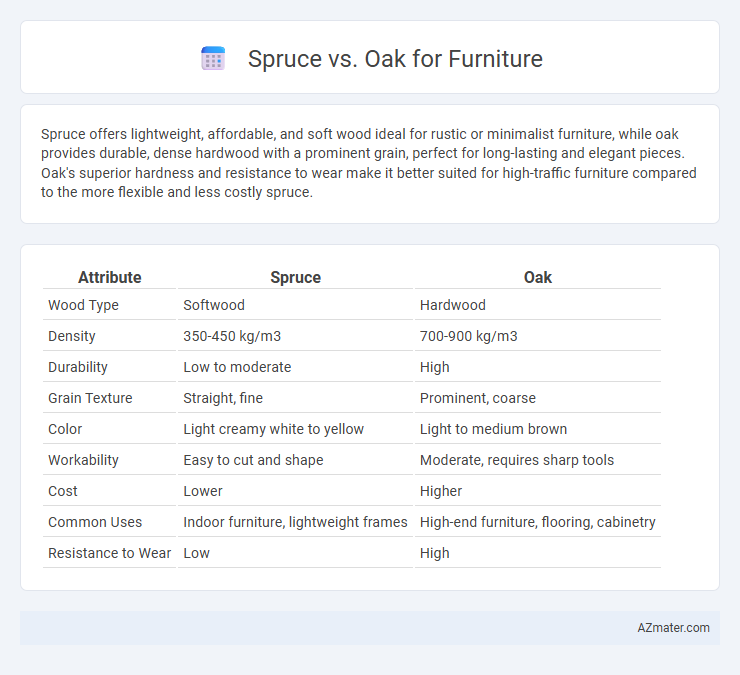Spruce offers lightweight, affordable, and soft wood ideal for rustic or minimalist furniture, while oak provides durable, dense hardwood with a prominent grain, perfect for long-lasting and elegant pieces. Oak's superior hardness and resistance to wear make it better suited for high-traffic furniture compared to the more flexible and less costly spruce.
Table of Comparison
| Attribute | Spruce | Oak |
|---|---|---|
| Wood Type | Softwood | Hardwood |
| Density | 350-450 kg/m3 | 700-900 kg/m3 |
| Durability | Low to moderate | High |
| Grain Texture | Straight, fine | Prominent, coarse |
| Color | Light creamy white to yellow | Light to medium brown |
| Workability | Easy to cut and shape | Moderate, requires sharp tools |
| Cost | Lower | Higher |
| Common Uses | Indoor furniture, lightweight frames | High-end furniture, flooring, cabinetry |
| Resistance to Wear | Low | High |
Introduction: Comparing Spruce and Oak for Furniture
Spruce and oak both offer distinct advantages for furniture-making, with spruce being lightweight, softwood known for its pale color and fine grain, ideal for budget-friendly projects and easy shaping. Oak, a dense hardwood, provides exceptional durability, rich grain patterns, and resistance to wear, making it a premium choice for long-lasting, high-quality furniture. Choosing between spruce and oak depends on factors like desired strength, aesthetic appeal, and budget constraints.
Wood Characteristics: Spruce vs Oak
Spruce wood offers a lightweight and soft texture with a fine, even grain, making it ideal for detailed carving and a natural, pale finish, while oak provides a heavy, dense, and hard structure with prominent grain patterns and exceptional durability. Oak's high tannin content contributes to its resistance to fungal attacks and moisture, making it suitable for long-lasting furniture, whereas spruce requires protective finishes to enhance its vulnerability to dents and scratches. The contrast between spruce's affordability and workability and oak's strength and timeless appeal defines their distinct roles in furniture manufacturing and design.
Durability and Longevity
Spruce offers lightweight and affordable options for furniture but is less durable and prone to dents and scratches compared to oak. Oak features high density and hardness, providing exceptional strength and resistance to wear, making it ideal for long-lasting furniture pieces. Choosing oak ensures superior longevity and durability, especially for items subjected to heavy use or weight-bearing functions.
Appearance and Grain Patterns
Spruce furniture typically features a pale, light-colored appearance with a straight, uniform grain that offers a clean and minimalistic aesthetic. Oak furniture displays a richer, warm tone with pronounced grain patterns, including prominent swirls and rays, creating a more textured and classic look. The choice between spruce and oak depends on whether a preference leans towards subtle simplicity or bold, intricate natural patterns.
Workability and Ease of Crafting
Spruce offers excellent workability due to its soft texture and straight grain, making it easy to cut, shape, and sand for furniture crafting. Oak, while harder and denser, holds up well under heavy use but requires sharper tools and more effort to work due to its coarse grain and natural tannins. Craftsmen often prefer spruce for intricate designs and detailed joinery, whereas oak is favored for durable, long-lasting pieces despite its slightly more challenging workability.
Cost Comparison: Spruce vs Oak
Spruce furniture typically costs significantly less than oak due to its faster growth rate and greater availability, making it a budget-friendly option for large projects. Oak, prized for its durability and rich grain, commands a higher price point, often double or more than spruce depending on the cut and finish. When comparing long-term investment, oak's longevity and resistance to wear justify its premium cost despite spruce's initial affordability.
Environmental Impact and Sustainability
Spruce furniture is often favored for its rapid growth and lower carbon footprint compared to oak, making it a more sustainable option in terms of resource renewable rate and forest regeneration. Oak, while denser and longer-lasting, requires longer harvesting cycles and often comes from slower-growing hardwood forests, impacting biodiversity and carbon sequestration negatively. Choosing spruce supports reduced environmental impact through faster replenishment and less intensive land use, aligning with eco-friendly furniture production goals.
Maintenance and Care Requirements
Spruce furniture typically requires regular sealing or varnishing to protect its softwood surface from dents and moisture damage, making maintenance more frequent but straightforward. Oak furniture, known for its hardness and dense grain, demands less frequent care, mainly involving dusting and occasional polishing to maintain its durability and natural luster. Both woods benefit from avoiding excessive water exposure and using gentle, wood-specific cleaning products to extend their lifespan.
Best Uses for Spruce and Oak in Furniture
Spruce is ideal for lightweight furniture such as cabinets, shelves, and accent pieces due to its soft texture and ease of shaping. Oak's durability and dense grain make it best suited for heavy-use furniture like dining tables, chairs, and flooring that require long-lasting strength. Both woods offer distinct aesthetic qualities; spruce features a pale, uniform appearance, while oak displays rich grain patterns perfect for traditional or rustic designs.
Conclusion: Choosing the Right Wood for Your Needs
Spruce offers a lightweight, affordable option with good workability, ideal for projects prioritizing ease of handling and budget. Oak provides superior durability and a rich grain, making it suitable for furniture that requires long-lasting strength and aesthetic appeal. Selecting between spruce and oak depends on whether you value cost-efficiency and lightness or enhanced robustness and visual character.

Infographic: Spruce vs Oak for Furniture
 azmater.com
azmater.com